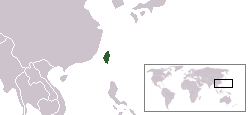 Taiwan, also known as Formosa (from Portuguese: Ilha Formosa, “Beautiful Island”), is an island situated in East Asia in the Western Pacific Ocean and located off the southeastern coast of mainland China. It comprised most (99%) of the territory of the Republic of China(ROC) since the 1950s. The term “Taiwan” has also become a commonly used alternative name both domestically and internationally to refer to the entire country of Republic of China after the ROC lost international diplomatic recognition as “China” in the 1970s.
Taiwan, also known as Formosa (from Portuguese: Ilha Formosa, “Beautiful Island”), is an island situated in East Asia in the Western Pacific Ocean and located off the southeastern coast of mainland China. It comprised most (99%) of the territory of the Republic of China(ROC) since the 1950s. The term “Taiwan” has also become a commonly used alternative name both domestically and internationally to refer to the entire country of Republic of China after the ROC lost international diplomatic recognition as “China” in the 1970s.
Separated from the Asian continent by the 120 kilometres (75 mi) wide Taiwan Strait, the main island of the group is 394 kilometres (245 mi) long and 144 kilometres (89 mi) wide. To the northeast are the main islands of Japan and the East China Sea, and the southern end of the Ryukyu Islands of Japan is directly to the east; the Philippines lie to its south across the Bashi Channel. The mountainous island spans the Tropic of Cancer and is covered by tropical and subtropical vegetation. Other minor islands and islets of the group include the Pescadores, Green Island, and Orchid Island as well as the Diaoyutai Islands (Senkaku-shotō) which have been controlled by Japan since the 1970s.
Taiwan has been governed by the Republic of China since 25 October 1945 when the Republic of China acquired Taiwan from the Empire of Japan as a result of World War II. Four years later the Republic of China lost mainland China in the Chinese Civil War to the Communists and retreated to Taiwan.
Taiwan since the 1950s has composed of the vast majority of the ROC’s territory. This is among one of the multiple factors that the ROC is commonly known as “Taiwan”. The political status of Taiwan is disputed because it is claimed by the People’s Republic of China (PRC) which was established in 1949 on mainland China and considers itself the successor state to the ROC.
Japan had originally acquired Taiwan from the Qing Empire in 1895 per Article 2 of the Treaty of Shimonoseki. At the end of World War II, Japan renounced all claims to sovereignty over its former colonial possessions, including Taiwan and Penghu (Pescadores), but did not specify to whom Taiwan and Penghu should be assigned. This fact and subsequent handling of Taiwan’s sovereignty by the Allies of World War II led to the complex and unresolved issues of the legal and political status of Taiwan.
Taiwan’s rapid economic growth in the decades after World War II has transformed it into an advanced economy as one of the Four Asian Tigers. This economic rise is known as the Taiwan Miracle. It is categorized as an advanced economy by the IMF and high-income economy by the World Bank. Its technology industry plays a key role in the global economy. Taiwanese companies manufacture a large portion of the world’s consumer electronics, although most of them are now made in their factories in mainland China.

Notes from Wikipedia








